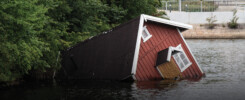At least 53 tornadoes were reported this past week within the central United States, ringing the warning sirens of what would appear to be another historical year of extreme weather conditions.
The combination of tornadoes and historic flooding has created a high-risk situation for residents in the southern United States. Storm chasers are navigating through uncharted territory as they track these extreme weather conditions up close, highlighting the urgent need for preparedness and safety measures in the face of this apocalyptic storm system.
The tornadoes caused widespread damage to homes, businesses, and infrastructure in several states, with thousands of residents being displaced and left without power. Emergency crews have been working around the clock to assess the damage and assist those in need. The severe weather has also led to numerous road closures and travel disruptions, further complicating recovery efforts in the affected areas. Residents are urged to stay vigilant and heed all safety warnings issued by local authorities as the threat of severe weather continues in the coming days. According to the National Weather Service (NWS) as of Friday, 53 tornado reports were filed and 33 of those were confirmed. The number of confirmed to reported is expected to slightly increase as more data is reviewed.
At least 3 tornadoes were determined to be EF3 on the Enhanced Fujita Scale— one in Lake City, Arkansas, another in Selmer, Tennessee, and one in Potosi, Missouri. At least seven people were killed by the storms, including flooding deaths. As more reports are confirmed, it is likely the number of deaths will increase. Search and rescue teams are working tirelessly day and night to ensure everyone affected is accounted for.
At least one tornado was reported each day from March 28 through April 3. A tornado outbreak on Sunday, March 30, produced dozens of tornado reports from Mississippi to Michigan— along with a late-season ice storm in Michigan.
The most significant severe weather outbreak occurred Wednesday into Wednesday night. From 8 a.m. EDT Wednesday through the same time Thursday, the National Weather Service (NWS) issued 728 severe thunderstorm and tornado warnings — making it the third-busiest severe weather day since records began in 1986. This intense storm system has posed unprecedented challenges for emergency management teams and residents in the affected areas, emphasizing the importance of preparedness and quick response in the face of extreme weather events.
CNN: Tracking destructive and deadly tornadoes in the US, in maps and charts
Tornadoes weren’t the only story — hail and high winds caused damage across a 1,500-mile swath of the nation. During that period, 495 high wind reports and 208 hail reports were filed. On Thursday, just one tornado report was received, but there were another 61 high wind reports and 46 hail reports. In Nashville, water rescues were performed Thursday morning after particularly heavy rainfall. Additionally, the ongoing severe weather conditions have raised concerns about potential flash flooding and landslides in the region, prompting local authorities to issue warnings and evacuation orders in at-risk areas. Residents are advised to stay informed and take necessary precautions to ensure their safety during this critical time.
By Friday morning, hundreds of flood warnings were in effect from Texas to Pennsylvania. Historic, life-threatening flooding is forecast to impact parts of Arkansas, western Tennessee, and Kentucky through the weekend. Water levels rise quickly and only takes minutes to hours for rising waters to submerge roads, bridges, and homes. Residents are urged to stay vigilant and follow evacuation orders to ensure their safety during this unprecedented flooding event.
Credits for videos and images solely belong to the original sources or creators of the content. We do not profit in any way for reusing shared content.

